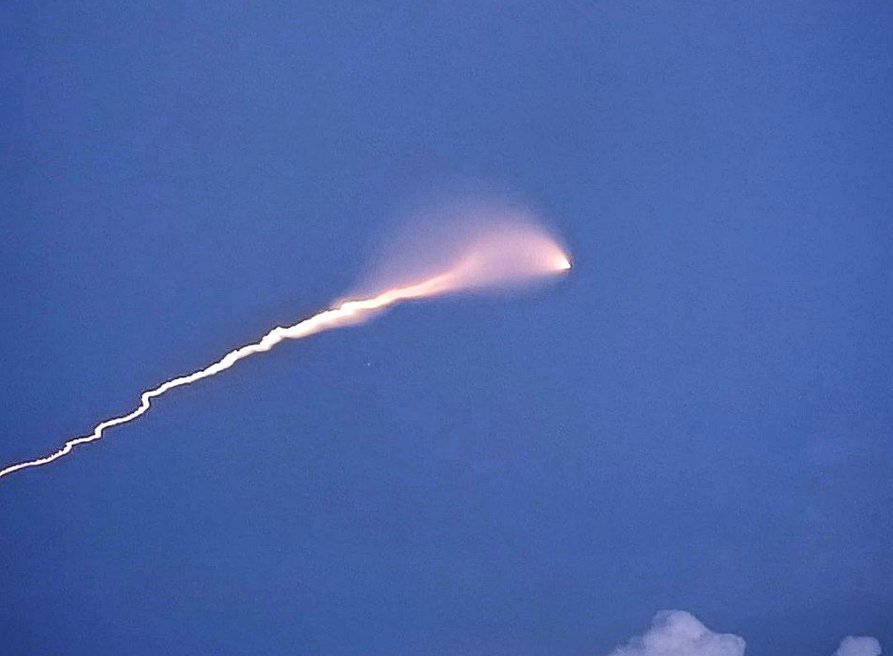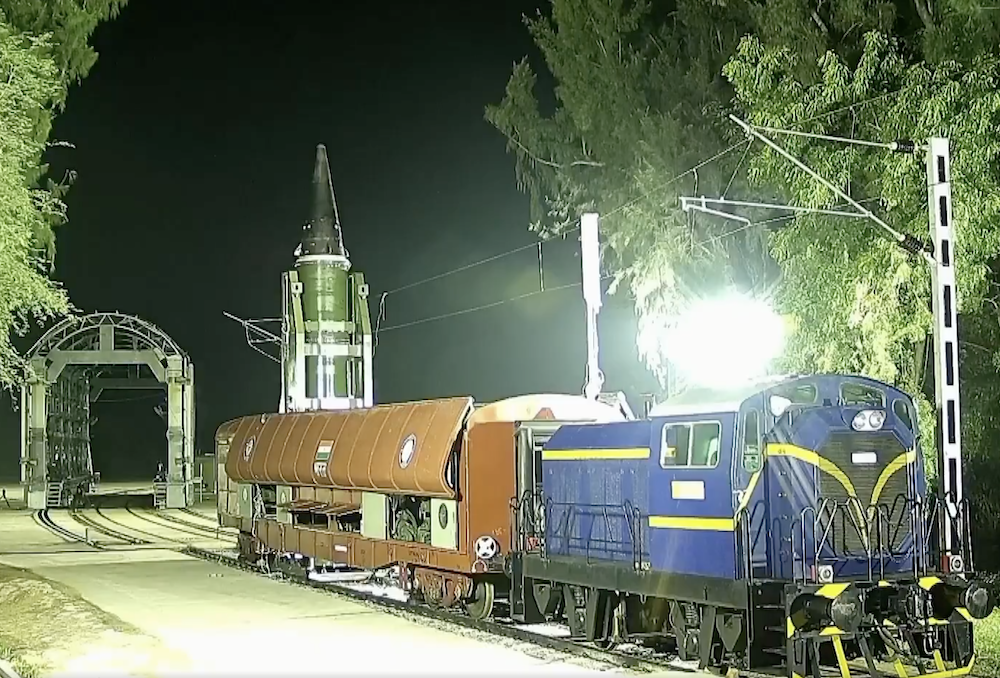 This screenshot taken from an amateur video shows the Agni-5 missile flying towards its target during its test.
This screenshot taken from an amateur video shows the Agni-5 missile flying towards its target during its test.
New Delhi: India successfully test-fired its Agni-5 (Agni V) intermediate-range ballistic missile from the Integrated Test Range at Chandipur in Odisha on Wednesday. This test of the strategic missile comes just over a week before the prime minister, Narendra Modi, is scheduled visit to China for the Shanghai Cooperation Organization summit in Tianjin.
The Agni-5 missile system has undergone multiple tests since its first launch in 2012, with the latest demonstration confirming its operational readiness for deployment.
The test, conducted under the Strategic Forces Command’s supervision, validated all operational and technical parameters of the indigenously developed weapon system. Defence officials described the launch as part of routine user trials designed to maintain India’s credible minimum deterrence posture.
Reports indicate India has just carried out a test launch of the AGNI-5 Intercontinental Ballistic Missile, using NOTAM data, here is a map outlining the missile’s 4,790 km tested range https://t.co/AhcIOwVVl7 pic.twitter.com/MnIJqpdqWD
— Damien Symon (@detresfa_) August 20, 2025
The timing carries significant diplomatic weight, occurring amid a complex geopolitical situation where New Delhi faces pressure from multiple directions, including sanctions-like tariff imposed on imports of Indian goods by the United States president, Donald Trump.
The test follows the visit of the Chinese foreign minister, Wang Yi, to New Delhi, which concluded on Tuesday, where he met Modi and held boundary talks with the national security advisor, Ajit Doval. These engagements set the stage for Modi’s participation in the SCO summit, which is widely seen as a mark of a potential thaw in India-China relations following the deadly Galwan valley clashe in June 2020.
Strategic analysts suggest the missile test represents calculated messaging, demonstrating India’s technological advancement and strategic resolve before high-level diplomatic engagement. The Agni-5’s operational range exceeding 5,000 kilometres places China’s major population and industrial centres within striking distance, fundamentally altering the regional balance of power.
“The message is clear - India approaches this relationship as an equal partner, not a subordinate regional power,” said a senior defence official who requested anonymity. The demonstration eliminates China’s previous geographical advantage and forces Beijing to recalculate its strategic approach toward India.
?? Start der Agni-5 ICBM Indiens verblüfft die Zuschauer
— ???ℝℕ?ℂ??ℝ?™️ ? (@Eiernockerln) August 20, 2025
Die Rakete ist der KERN der nuklearen Abschreckung Indiens ?
Hat eine Reichweite von über 5.000 km und eine Geschwindigkeit von Mach 24❗️ pic.twitter.com/bbc27Zwabc
Technical capabilities
The Agni-5 represents the pinnacle of India’s missile technology, developed by the Defence Research and Development Organisation under the Integrated Guided Missile Development Programme initiated in 1983. The three-stage solid-fuel missile measures 17.5 metres in length with a launch mass of 50,000 kilograms.
Crucially, the weapon system incorporates MIRV (multiple independently targetable reentry vehicle) technology, which was successfully demonstrated in the March 2024 “Mission Divyastra” test, as India Sentinels had reported then. This capability allows a single missile to carry three to four nuclear warheads that can strike multiple targets hundreds of kilometres apart, overwhelming ballistic missile defence systems.
The missile employs advanced guidance systems including ring laser gyro-based inertial navigation and thrust vector control, ensuring exceptional accuracy with a circular error probable under 100 metres. Its canisterized launch system enables “cold launch” deployment from sealed containers, enhancing survivability and rapid deployment capability.
Chinese analysts have suggested the missile’s actual range may extend to 8,000 kilometres, though DRDO officially maintains the 5,000-kilometre specification. Reports indicate development of an extended-range version capable of reaching 7,500 kilometres, further expanding India’s strategic reach across Asia and parts of Europe.
Wednesday’s test also reinforces India’s nuclear doctrine of credible minimum deterrence coupled with a “no first use” policy established in 2003. The doctrine emphasizes deterrence by punishment rather than denial, targeting adversary population centres and industrial infrastructure rather than military forces.
The Agni-5’s survivability features, including road mobility and canisterized launch systems, ensure credible second-strike capability even after absorbing a first strike. This survivability proves crucial for maintaining the NFU posture’s credibility while supporting the doctrine’s massive retaliation component.
India’s achievement places it among an exclusive group possessing MIRV technology, alongside the United States, Russia, China, France, and the United Kingdom. Pakistan claims similar capability with its Ababeel missile, though this remains unverified.
For Pakistan, while already within range of India’s shorter-range Agni and Prithvi missiles, the enhanced accuracy and MIRV capability significantly amplify the deterrent effect. Pakistani strategic analysts have expressed concern that India’s Missile Technology Control Regime (MTCR) membership since 2016 has accelerated missile development, potentially destabilizing regional balance.
The Strategic Vision Institute, a Pakistani thinktank, warns that future Agni variants could potentially reach Washington, Moscow, and Beijing, elevating India’s strategic significance beyond regional considerations.
The missile’s development demonstrates India’s growing indigenous defence capabilities, while reducing dependence on foreign suppliers for critical defence technologies. DRDO’s network of 52 laboratories has evolved from modest beginnings in 1958 into India’s largest and most diverse defence research organization.
Future developments
DRDO continues developing the Agni-6 (Agni VI) intercontinental ballistic missile with an expected range of 11,000–12,000 kilometres and capability to carry 10 MIRV warheads. This system would provide India with genuine global reach and significantly enhanced strategic flexibility.
Recent reports suggest development of conventional Agni-5 variants for the Indian Air Force, featuring massive 7.5–8-tonne warheads designed for deep penetration applications. These conventional variants would provide precision strike capabilities against heavily fortified targets without crossing the nuclear threshold.
India’s development of submarine-launched ballistic missiles based on Agni technology will complete its nuclear triad, providing a truly survivable second-strike capability through platforms difficult to locate and target.
The successful test marks India’s arrival as a mature nuclear power capable of credible deterrence across continental distances. The advanced capabilities demonstrate technological sophistication and strategic resolve while establishing India as an equal participant in great power competition.
As regional tensions evolve and new challenges emerge, the Agni-5 provides India with strategic flexibility and deterrent credibility necessary to protect interests while contributing to stability through strength. This transformation carries profound implications for Asian security architecture and the broader global balance of power in the 21st century.


